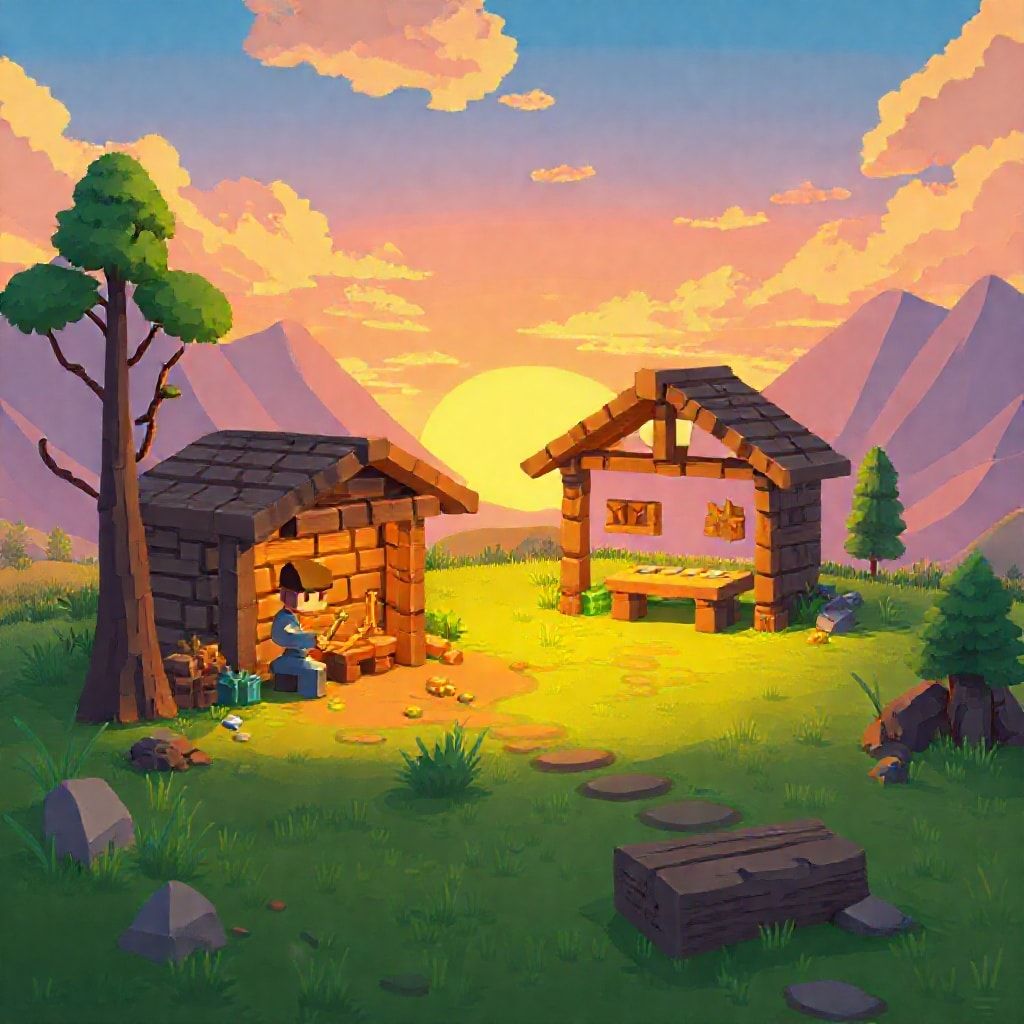
In the vast, ever-evolving landscape of video games, few genres have captured the imagination and dedication of players quite like Open-World Survival Games (OWSGs). What started as a niche fascination has blossomed into a global phenomenon, redefining what it means to play, to explore, and to create. This isn’t just about fighting monsters or finding loot; it’s about the profound freedom to carve your own story, build your own world, and test the limits of your creativity against unforgiving odds.
From the moment you awaken in a harsh, unfamiliar environment with nothing but the clothes on your back, OWSGs challenge you to survive, adapt, and thrive. They offer a unique blend of adrenaline-pumping danger, strategic resource management, and boundless creative expression. Let’s delve into how this captivating genre has evolved, captivating millions and shaping the future of interactive entertainment.
What Defines an Open-World Survival Game?
At its core, an Open-World Survival Game thrusts players into a dynamic, often hostile environment with minimal guidance. The objective isn’t to follow a linear questline, but to endure. This fundamental premise branches out into several key characteristics:
The Core Loop: Survive, Explore, Build
The heartbeat of any OWSG is its core gameplay loop. You start with nothing, forcing you to immediately engage with the world: gather resources (wood, stone, food), craft basic tools and shelters, and manage your character’s needs (hunger, thirst, health, temperature). The world itself is a character, often procedurally generated or meticulously designed to offer vast, diverse biomes ripe for exploration. As you venture further, you discover new resources, encounter new threats, and unlock more advanced crafting possibilities, leading to the ultimate goal: building a secure, self-sufficient base.
Player Agency and Emergent Gameplay
Unlike many narrative-driven games, OWSGs rarely dictate your path. There’s no grand hero’s journey pre-written for you. Instead, the story emerges from your decisions, your interactions with the environment, and often, your encounters with other players. Do you become a benevolent builder, a ruthless raider, or a solitary explorer? The choices are yours, leading to unique, unscripted moments that become personal anecdotes and community legends. This emphasis on player agency is a cornerstone of the genre’s appeal.
From Pixels to Photorealism: A Brief History
The roots of open-world survival games can be traced back to simpler times, laying the groundwork for the complex, immersive experiences we enjoy today.
Early Pioneers: Minecraft and DayZ
While not strictly a “survival game” in its initial iterations, Minecraft (2011) undeniably popularized the core mechanics that would define the genre: resource gathering, crafting, base building, and exploration within a vast, procedurally generated world. Its blocky aesthetic belied a profound freedom that allowed players to build anything they could imagine, while its survival mode introduced elements of hunger, hostile mobs, and the need for shelter.
Almost concurrently, the DayZ mod for Arma 2 (2012) burst onto the scene, offering a starkly different, much harsher vision. This was survival stripped bare: a post-apocalyptic landscape, scarce resources, permadeath, and the terrifying knowledge that other players were often the greatest threat. DayZ pioneered the intense, high-stakes PvPvE (Player vs. Player vs. Environment) dynamics that would become synonymous with many later survival titles.
The Golden Age of Crafting and Base Building
Inspired by these trailblazers, a new wave of OWSGs refined and expanded the formula. Games like Rust (2013), Ark: Survival Evolved (2015), and Subnautica (2018) pushed boundaries with more complex crafting trees, intricate base-building systems, and increasingly sophisticated environments. Rust became infamous for its brutal player-versus-player encounters and the constant threat of losing everything. Ark introduced creature taming, allowing players to ride dinosaurs and other prehistoric beasts, adding a new layer of strategy and power fantasy. Subnautica, on the other hand, offered a unique underwater survival experience, blending exploration, base building, and a compelling mystery narrative in a truly alien world.
Unpacking the Appeal: Why We Love to Survive
What is it about the constant struggle for existence that keeps players coming back for more? The appeal of OWSGs lies in several deeply satisfying psychological elements.
The Thrill of Overcoming Adversity
There’s an unparalleled sense of accomplishment that comes from starting with nothing and slowly, painstakingly, building a fortress, crafting powerful tools, and mastering a hostile environment. Every successful raid, every new resource discovered, every night survived against the odds feels like a genuine victory. It’s a primal satisfaction, a testament to resilience and ingenuity.
Unfettered Freedom and Exploration
The “open-world” aspect is crucial. These games offer truly expansive, often seamless maps that invite endless exploration. There are no invisible walls, no strictly defined paths. Players are free to wander, discover hidden caves, vast oceans, towering mountains, and mysterious ruins. This freedom fuels curiosity and a sense of adventure, encouraging players to forge their own paths and uncover the world’s secrets at their own pace.

Unleashing Creativity: From Shacks to Skyscrapers
Perhaps the most compelling aspect for many is the creative outlet. Base building is not just a functional necessity; it’s an art form. Players invest countless hours designing elaborate fortresses, cozy homes, efficient industrial complexes, and even whimsical structures that serve no purpose other than to impress. The ability to shape the world around you, to leave your unique mark on the landscape, taps into a fundamental human desire to create and express oneself.
The Evolution Continues: Innovation and Niche Experiences
The genre isn’t static; it’s constantly evolving, with developers finding new ways to innovate and expand the survival experience.
Expanding Horizons: Valheim, Grounded, Palworld
Valheim (2021) brought a refreshing take with its Norse mythology setting, focus on co-operative play, and satisfying progression system that tied base building and crafting directly to defeating powerful bosses. Grounded (2020) offered a unique perspective by shrinking players to the size of an ant, transforming a familiar backyard into a perilous, giant-sized open world filled with menacing insects. More recently, Palworld (2024) exploded onto the scene by blending creature collection and combat with the familiar survival crafting loop, proving there’s still ample room for genre mash-ups and fresh ideas.

Narrative Depth in Survival
While many OWSGs are player-driven sandboxes, some have successfully woven compelling narratives into their survival mechanics. Subnautica, as mentioned, is a prime example, where discovering the fate of your crashed ship and the alien world you’re stranded on becomes a powerful motivator alongside basic survival. These games demonstrate that “survival” doesn’t have to mean a lack of story; it can, in fact, make the narrative stakes even higher.
The Impact on Gaming Culture
The rise of open-world survival games has had a profound impact far beyond their immediate player base.
Community and Content Creation
OWSGs are a goldmine for content creators. The emergent gameplay, the dramatic player interactions, and the sheer scale of creative builds make for incredibly engaging streaming and YouTube content. Communities flourish around these games, sharing tips, showcasing epic bases, organizing events, and even creating elaborate role-playing scenarios. The modding scene is also incredibly active, further extending the life and possibilities of these titles.

Shaping Future Game Design
The success of OWSGs has influenced game design across the board. Elements like crafting systems, base building, and environmental storytelling are now common in many other genres. The emphasis on player choice, sandbox elements, and emergent narrative has shown developers that giving players freedom can lead to incredibly rich and long-lasting experiences. The genre has proven that players crave not just entertainment, but also the tools and freedom to be creators themselves.
Conclusion
The journey of open-world survival games, from their humble beginnings to their current status as a gaming powerhouse, is a testament to the enduring appeal of freedom, challenge, and creativity. They offer a unique escape, a digital canvas where players can test their mettle, build their dreams, and forge unforgettable stories. As technology advances and developers continue to innovate, the future of this genre looks brighter than ever, promising even more immersive worlds, deeper mechanics, and boundless opportunities for players to survive, explore, and create. So, what will you build next, and what story will you tell?






